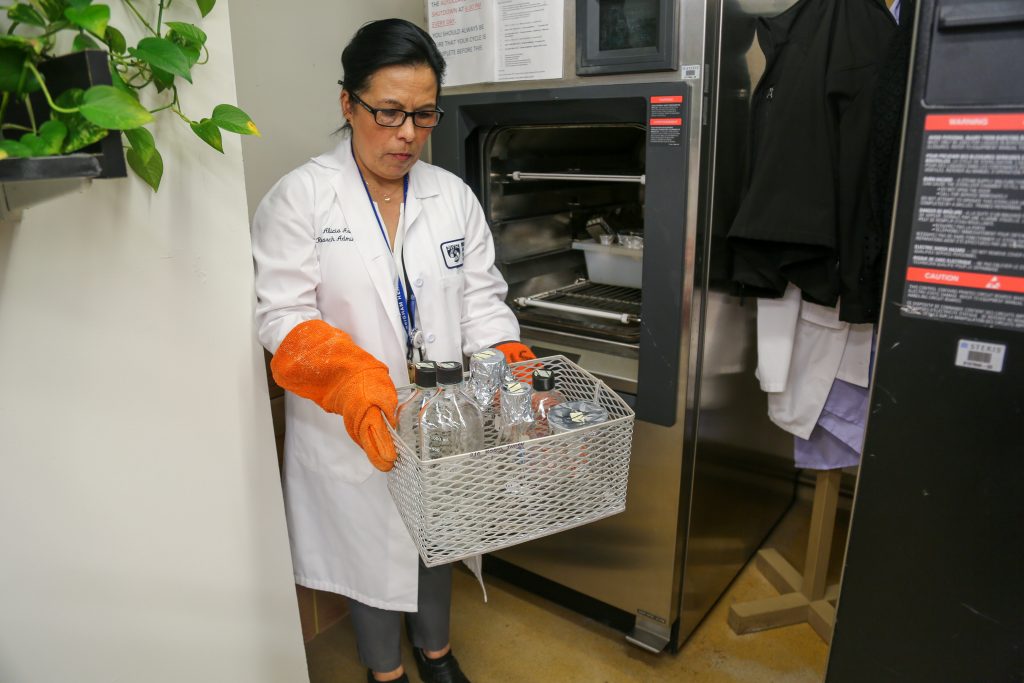Behind the Scenes at the Brigham: Glasswash and Sterilization Facilities

Alicia Arevalo removes glassware from the autoclave.
When Brigham researchers finish their work in the laboratory, the equipment they use needs to be thoroughly cleaned not only to keep the environment safe but also to prevent contamination in future studies. But these beakers, flasks, funnels, graduated cylinders and similar tools require a more rigorous cleansing than typical glassware. That’s where Alicia Arevalo comes in.
Arevalo serves as the manager of the Brigham’s three Glasswash and Sterilization facilities — located in the Thorn Building, New Research Building and Hale Building for Transformative Medicine — which are responsible for sterilizing glass and plastic containers that research faculty, staff and trainees employ in the lab. The facilities contain specialized washing machines that use powerful, high-temperature water jets in combination with sanitizers to ensure each instrument is free of any debris or lingering microorganisms.
A Brigham employee for nearly two decades, Arevalo essentially operates the Glasswash and Sterilization Facilities as a one-woman show. But because she can’t be everywhere all the time, she has trained scores of colleagues on how to properly use the machines when she is not present. Each training session is over an hour long and covers a range of safety procedures. Nobody is permitted to use the sterilization facilities without completing a training module with Arevalo.
“It doesn’t matter if you are a student or a doctor. Everyone is expected to treat these machines with care and make sure they are being as safe as possible,” said Arevalo.
Every Detail Counts
There are three fundamental rules for washing lab equipment: fill the tray with the materials that need to be washed; close the door; and select the appropriate wash cycle. It sounds simple enough, but don’t be deceived. It’s not exactly like loading your kitchen dishwasher at home.
Each step must adhere to stringent safety regulations — including proper disposal of waste materials before washing, using the right machine for instrument and wearing appropriate safety gear.
As part of her training module, Arevalo shows a binder of images depicting melted containers, broken glass and plastic shards as a reference for what can happen when safety protocols are not followed. (In case that doesn’t resonate, she also keeps a bucket of misused instruments as tangible examples.) The binder also features diagrams and instructions for the proper use of each machine in the facilities.
“When training, I can spend hours talking about what precautions to take, but words don’t reach people as well as photographs and real-life examples,” Arevalo said.
But it’s not just about keeping the integrity of the machines and materials, said Arevalo. It’s also about keeping everyone safe.
“Some of the containers I receive are delivered from departments that handle hazardous materials, including radioactive waste,” she explained. “It would be horrible if the machine stopped working properly and those containers were not completely washed.”
A Home Away from Home
The Brigham has become like a second home, Arevalo said, and her role has given her the chance to meet new people every day and feel more connected to the Brigham community at large.
“Although it seems like I work independently, teamwork plays a big part in my day,” she said. “Without proper equipment care, research can’t be completed, so I love that my job makes an impact.”
 Angela Vail, executive director in Office of the Chief Academic Officer and Arevalo’s longtime supervisor, can attest to the warm environment she creates.
Angela Vail, executive director in Office of the Chief Academic Officer and Arevalo’s longtime supervisor, can attest to the warm environment she creates.
“Alicia always offers help to anyone stopping by for glass washing. She takes great pride in keeping her work areas clean and making sure everyone has what they need to get their own work done,” said Vail.
To help her colleagues feel at home too, Arevalo incorporates her love for nature into the Glasswash and Sterilization Facilities. The walls adjacent to her desk in Thorn are embellished with colorful photos of flowers and butterflies to maintain a welcoming atmosphere. To complement her floral décor, she keeps a collection of plants along the perimeter of the facility, which she tends to between wash cycles.
“I look forward to coming here every day, and I want my colleagues to feel the same,” Arevalo said.
“Behind the Scenes at the Brigham” is a monthly series in Brigham Bulletin that provides a glimpse of the people whose everyday contributions help make the Brigham a world-class institution. Is there an individual or team you’d like to see featured? Send your ideas to bulletin@bwh.harvard.edu.

Leave a Reply